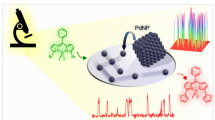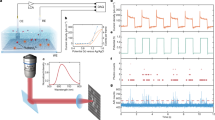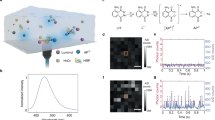Abstract
Super-resolved fluorescence microscopy techniques have enabled substantial advances in the chemical and biological sciences. However, they can only interrogate entities that fluoresce, and most chemical or biological processes do not involve fluorescent species. Here we report a competition-enabled imaging technique with super-resolution (COMPEITS) that enables quantitative super-resolution imaging of non-fluorescent processes. It is based on the incorporation of competition into a single-molecule fluorescence-detection scheme. We demonstrate COMPEITS by investigating a photoelectrocatalytic reaction; we map, with nanometre precision, a non-fluorescent surface reaction that is important for water decontamination on single photocatalyst particles. The subparticle-level quantitative information of reactant adsorption affinities unambiguously decouples size- and shape-scaling laws on specific particle facets and uncovers a surprising biphasic shape dependence, leading to catalyst design principles for optimal reactant adsorption efficacy. With its ability to provide spatially resolved information on the behaviours of unlabelled, non-fluorescent entities under operando conditions, COMPEITS could interrogate a variety of surface processes in fields ranging from heterogeneous catalysis and materials engineering to nanotechnology and energy sciences.
This is a preview of subscription content, access via your institution
Access options
Access Nature and 54 other Nature Portfolio journals
Get Nature+, our best-value online-access subscription
$29.99 / 30 days
cancel any time
Subscribe to this journal
Receive 12 print issues and online access
$259.00 per year
only $21.58 per issue
Buy this article
- Purchase on Springer Link
- Instant access to full article PDF
Prices may be subject to local taxes which are calculated during checkout




Similar content being viewed by others
Data availability
The data that support the findings of this study are available from the corresponding author on reasonable request.
Code availability
The MATLAB codes that support the findings of this study are available from the corresponding author on reasonable request.
References
Jiang, Y. et al. Electron ptychography of 2D materials to deep sub-ångström resolution. Nature 559, 343–349 (2018).
Fan, C. et al. X-ray and cryo-EM structures of the mitochondrial calcium uniporter. Nature 559, 575–579 (2018).
de Smit, E. et al. Nanoscale chemical imaging of a working catalyst by scanning transmission X-ray microscopy. Nature 456, 222–225 (2008).
Wu, C. Y. et al. High-spatial-resolution mapping of catalytic reactions on single particles. Nature 541, 511–515 (2017).
Jaramillo, T. F. et al. Identification of active edge sites for electrochemical H2 evolution from MoS2 nanocrystals. Science 317, 100–102 (2007).
Tao, F. et al. Break-up of stepped platinum catalyst surfaces by high CO coverage. Science 327, 850–853 (2010).
von Diezmann, A., Shechtman, Y. & Moerner, W. E. Three-dimensional localization of single molecules for super-resolution imaging and single-particle tracking. Chem. Rev. 117, 7244–7275 (2017).
Betzig, E. et al. Imaging intracellular fluorescent proteins at nanometer resolution. Science 313, 1642–1645 (2006).
Gaiduk, A., Yorulmaz, M., Ruijgrok, P. V. & Orrit, M. Room-temperature detection of a single molecule’s absorption by photothermal contrast. Science 330, 353–356 (2010).
Fang, Y. M. et al. Intermittent photocatalytic activity of single CdS nanoparticles. Proc. Natl Acad. Sci. USA 114, 10566–10571 (2017).
Hell, S. W. & Wichmann, J. Breaking the diffraction resolution limit by stimulated-emission: stimulated-emission-depletion fluorescence microscopy. Opt. Lett. 19, 780–782 (1994).
Betzig, E. et al. Imaging intracellular fluorescent proteins at nanometer resolution. Science 313, 1642–1645 (2006).
Rust, M. J., Bates, M. & Zhuang, X. W. Sub-diffraction-limit imaging by stochastic optical reconstruction microscopy (STORM). Nat. Methods 3, 793–795 (2006).
Sengupta, P., van Engelenburg, S. B. & Lippincott-Schwartz, J. Superresolution imaging of biological systems using photoactivated localization microscopy. Chem. Rev. 114, 3189–3202 (2014).
Hauser, M. et al. Correlative super-resolution microscopy: new dimensions and new opportunities. Chem. Rev. 117, 7428–7456 (2017).
Bintu, B. et al. Super-resolution chromatin tracing reveals domains and cooperative interactions in single cells. Science 362, eaau1783 (2018).
Gustavsson, A. K., Petrov, P. N., Lee, M. Y., Shechtman, Y. & Moerner, W. E. 3D single-molecule super-resolution microscopy with a tilted light sheet. Nat. Commun. 9, 123 (2018).
Balzarotti, F. et al. Nanometer resolution imaging and tracking of fluorescent molecules with minimal photon fluxes. Science 355, 606–612 (2017).
Nixon-Abell, J. et al. Increased spatiotemporal resolution reveals highly dynamic dense tubular matrices in the peripheral ER. Science 354, aaf3928 (2016).
Ristanovic, Z., Kubarev, A. V., Hofkens, J., Roeffaers, M. B. J. & Weckhuysen, B. M. Single molecule nanospectroscopy visualizes proton-transfer processes within a zeolite crystal. J. Am. Chem. Soc. 138, 13586–13596 (2016).
Tachikawa, T., Yonezawa, T. & Majima, T. Super-resolution mapping of reactive sites on titania-based nanoparticles with water-soluble fluorogenic probes. ACS Nano 7, 263–275 (2013).
Sambur, J. B. et al. Sub-particle reaction and photocurrent mapping to optimize catalyst-modified photoanodes. Nature 530, 77–80 (2016).
Zhang, Y. W. et al. Superresolution fluorescence mapping of single-nanoparticle catalysts reveals spatiotemporal variations in surface reactivity. Proc. Natl Acad. Sci. USA 112, 8959–8964 (2015).
Chen, T. et al. Optical super-resolution imaging of surface reactions. Chem. Rev. 117, 7510–7537 (2017).
Roeffaers, M. B. et al. Spatially resolved observation of crystal-face-dependent catalysis by single turnover counting. Nature 439, 572–575 (2006).
Xu, W., Kong, J. S., Yeh, Y. T. & Chen, P. Single-molecule nanocatalysis reveals heterogeneous reaction pathways and catalytic dynamics. Nat. Mater. 7, 992–996 (2008).
Mo, G. C. H. et al. Genetically encoded biosensors for visualizing live-cell biochemical activity at super-resolution. Nat. Methods 14, 427–434 (2017).
Folling, J. et al. Fluorescence nanoscopy by ground-state depletion and single-molecule return. Nat. Methods 5, 943–945 (2008).
Huang, H., Dorn, A., Nair, G. P., Bulovic, V. & Bawendi, M. G. Bias-induced photoluminescence quenching of single colloidal quantum dots embedded in organic semiconductors. Nano Lett. 7, 3781–3786 (2007).
Oishi, M., Tamura, A., Nakamura, T. & Nagasaki, Y. A smart nanoprobe based on fluorescence-quenching pegylated nanogels containing gold nanoparticles for monitoring the response to cancer therapy. Adv. Funct. Mater. 19, 827–834 (2009).
Sivula, K. & van de Krol, R. Semiconducting materials for photoelectrochemical energy conversion. Nat. Rev. Mater. 1, 15010 (2016).
Kim, T. W. & Choi, K. S. Nanoporous BiVO4 photoanodes with dual-layer oxygen evolution catalysts for solar water splitting. Science 343, 990–994 (2014).
Li, R. G. et al. Spatial separation of photogenerated electrons and holes among {010} and {110} crystal facets of BiVO4. Nat. Commun. 4, 1432 (2013).
Brandl, F., Bertrand, N., Lima, E. M. & Langer, R. Nanoparticles with photoinduced precipitation for the extraction of pollutants from water and soil. Nat. Commun. 6, 7765 (2015).
Alsbaiee, A. et al. Rapid removal of organic micropollutants from water by a porous β-cyclodextrin polymer. Nature 529, 190–194 (2016).
Thomas, A. G. & Syres, K. L. Adsorption of organic molecules on rutile TiQ2 and anatase TiQ2 single crystal surfaces. Chem. Soc. Rev. 41, 4207–4217 (2012).
Voet, D., Voet, J. G. & Pratt, C. W. Fundamentals of Biochemistry: Life at the Molecular Level 4th edn (Wiley, 2013).
Schwarzenbach, R. P. et al. The challenge of micropollutants in aquatic systems. Science 313, 1072–1077 (2006).
Shannon, M. A. et al. Science and technology for water purification in the coming decades. Nature 452, 301–310 (2008).
Zhou, X. C., Xu, W. L., Liu, G. K., Panda, D. & Chen, P. Size-dependent catalytic activity and dynamics of gold nanoparticles at the single-molecule level. J. Am. Chem. Soc. 132, 138–146 (2010).
Zhou, X. C. et al. Quantitative super-resolution imaging uncovers reactivity patterns on single nanocatalysts. Nat. Nanotechnol. 7, 237–241 (2012).
Cadiau, A. et al. Hydrolytically stable fluorinated metal-organic frameworks for energy-efficient dehydration. Science 356, 731–735 (2017).
Sung Cho, H. et al. Extra adsorption and adsorbate superlattice formation in metal-organic frameworks. Nature 527, 503–507 (2015).
Alvarez, P. J. J., Chan, C. K., Elimelech, M., Halas, N. J. & Villagran, D. Emerging opportunities for nanotechnology to enhance water security. Nat. Nanotechnol. 13, 634–641 (2018).
Sholl, D. S. & Lively, R. P. Seven chemical separations to change the world. Nature 532, 435–437 (2016).
Mao, X. et al. Energetically efficient electrochemically tunable affinity separation using multicomponent polymeric nanostructures for water treatment. Energy Environ. Sci. 11, 2954–2963 (2018).
Shi, G. et al. Two-dimensional NaCl crystals of unconventional stoichiometries on graphene surface from dilute solution at ambient conditions. Nat. Chem. 10, 776–779 (2018).
Li, J. et al. 99TcO4 − remediation by a cationic polymeric network. Nat. Commun. 9, 3007 (2018).
Hodgson, G. K., Impellizzeri, S. & Scaiano, J. C. Dye synthesis in the pechmann reaction: catalytic behaviour of samarium oxide nanoparticles studied using single molecule fluorescence microscopy. Chem. Sci. 7, 1314–1321 (2016).
Chen, P. et al. Spatiotemporal catalytic dynamics within single nanocatalysts revealed by single-molecule microscopy. Chem. Soc. Rev. 43, 1107–1117 (2014).
Ng, J. D. et al. Single-molecule investigation of initiation dynamics of an organometallic catalyst. J. Am. Chem. Soc. 138, 3876–3883 (2016).
ANDOR IQ v3 (Oxford Instruments, 2019).
Chen, T. Y. et al. Concentration- and chromosome-organization-dependent regulator unbinding from DNA for transcription regulation in living cells. Nat. Commun. 6, 7445 (2015).
Acknowledgements
The research on water pollutant degradation and super-resolution mapping was funded by the Army Research Office (grant no. W911NF-17-1-0590, and in part grant no. W911NF-18-1-0217). The research on BiVO4 synthesis, characterization and photoelectrochemistry was funded by the US Department of Energy, Office of Science, Basic Energy Sciences, Catalysis Science Program (grant no. DE-SC0004911). This research made use of the Cornell Center for Materials Research Shared Facilities, which are supported through the NSF MRSEC program (grant no. DMR-1719875). We thank W. Jung and G. Chen for helpful discussions on instrument construction and data analysis.
Author information
Authors and Affiliations
Contributions
X.M., C.L. and P.C. designed the research. X.M. synthesized the catalysts, constructed the instruments, performed the measurements, coded the software and analysed the data. X.M. and P.C. discussed the results and wrote the manuscript. M.H. and N.Z. contributed to the experiments.
Corresponding author
Ethics declarations
Competing interests
X.M. and P.C. have filed a provisional patent application ‘A competition-enabled imaging technique with super-resolution’ on 27 September 2018 with the US Patent Office (Provision Number 62/737,195).
Additional information
Publisher’s note: Springer Nature remains neutral with regard to jurisdictional claims in published maps and institutional affiliations.
Supplementary information
Supplementary Information
Supplementary materials and methods, Supplementary data and discussions, Supplementary Figs. 1–19, Supplementary Tables 1–7
Supplementary Video 1
A representative fluorescence video segment of the BiVO4 particle shown in Fig. 2 in the presence of 50 nM AR without HQ, at a frame rate of 133 frames per second (about twice the actual frame rate). Video frame dimensions: 10.1 × 12.5 μm2 (that is, 38 × 47 pixel2, in which each pixel is 266 × 266 nm2). Video length: 7,000 frames, which corresponds to an actual experimental time of 105 seconds. ImageJ is the preferred program for viewing this video at optimal quality. This video shows that there are stochastic appearances of the fluorescent product molecule resorufin from the auxiliary fluorogenic reaction of AR oxidation (that is, substantially brighter spots than the photoluminescence background of the BiVO4 particle) and those bright spots appear more frequently on the lateral facet of the particle than on its basal facet. A representative single-frame fluorescence image is shown in Supplementary Fig. 6.
Supplementary Video 2
A representative fluorescence video segment of the BiVO4 particle shown in Fig. 2 in the presence of 50 nM AR with 250 µM HQ, at a frame rate of 133 frames per second (about twice the actual frame rate). Video frame dimensions: 10.1 × 12.5 μm2 (that is, 38 × 47 pixel2, in which each pixel is 266 × 266 nm2). Video length: 7,000 frames, which corresponds to an actual experimental time of 105 seconds. ImageJ is the preferred program for viewing this video at optimal quality. This video shows that there are stochastic appearances of the fluorescent product molecule resorufin from the auxiliary fluorogenic reaction of AR oxidation (that is, substantially brighter spots than the photoluminescence background of the BiVO4 particle) and those bright spots appear more frequently on the lateral facet of the particle than on its basal facet. In the presence of the competitor HQ, the overall appearance frequency of the fluorescent product molecule decreases. A representative single-frame fluorescence image is shown in Supplementary Fig. 6.
Rights and permissions
About this article
Cite this article
Mao, X., Liu, C., Hesari, M. et al. Super-resolution imaging of non-fluorescent reactions via competition. Nat. Chem. 11, 687–694 (2019). https://doi.org/10.1038/s41557-019-0288-8
Received:
Accepted:
Published:
Issue Date:
DOI: https://doi.org/10.1038/s41557-019-0288-8
This article is cited by
-
Single-molecule mid-infrared spectroscopy and detection through vibrationally assisted luminescence
Nature Photonics (2023)
-
Inter-facet junction effects on particulate photoelectrodes
Nature Materials (2022)
-
Nanoscale cooperative adsorption for materials control
Nature Communications (2021)



